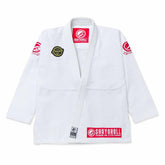Best Core Strengthening Exercises for BJJ: Unlock Explosive Power in Brazilian Jiu Jitsu
In the world of Brazilian Jiu Jitsu (BJJ), strength is essential. But not just any strength. The secret weapon of elite grapplers in both Gi and No-Gi BJJ lies in their core strength. A powerful, stable, and conditioned core is the engine behind explosive takedowns, impenetrable guard retention and lightning-fast transitions.
It does not matter whether you are training in a traditional BJJ Gi or preparing for a slippery, sweat-filled No-Gi BJJ roll. A rock-solid core can make the difference between domination and exhaustion. In this comprehensive guide, we will dive deep into the best core strengthening exercises for BJJ. Moreover, it will explore why the core matters so much in Brazilian Jiu Jitsu. And it will highlight how you can integrate these exercises into your training regimen.
Why Core Strength Is Crucial in Brazilian Jiu Jitsu
Before jumping into the exercises, it is vital to understand why core strength is so important in BJJ. Many people assume that core training is just about building abs. But in Brazilian Jiu Jitsu, the core includes your abdominals, obliques, lower back, hips and even your glutes.
Here's what your core does in BJJ:
- Maintains balance and posture during scrambles and guard play
- Generates power for sweeps, takedowns and submissions
- Protects your spine by stabilizing your body in extreme positions
- Improves guard retention by allowing quick hip movements and angles
- Supports breathing and endurance, especially when under pressure in Gi or No-Gi rolls
In short, the core is the center of every movement in Brazilian Jiu Jitsu. Strengthening it gives you control, fluidity, and explosiveness on the mat.
Best Core Strengthening Exercises for BJJ
Let’s break down the top core exercises for Brazilian Jiu Jitsu, detailing why each one is effective and how to perform it properly. These can be done with or without equipment and are suitable for both beginners and advanced grapplers.
1- Dead Bug (Anti-Extension Core Stability)
The dead bug is a deceptively simple movement. It challenges your deep core muscles to resist extension, mimicking the spinal stability needed during guard retention and bridging escapes.
How to do it:
- Lie on your back, arms extended toward the ceiling, knees bent at 90 degrees above your hips.
- Slowly extend your right leg and left arm toward the floor while keeping your lower back pressed into the ground.
- Return to the starting position and switch sides.
- Perform 3 sets of 10-12 controlled reps.
BJJ Benefit: Helps you maintain spinal integrity during inversions and guard work.
2- Plank with Shoulder Taps
This exercise enhances core stabilization while resisting rotation. It is a crucial skill during scrambles and when resisting an opponent’s pass.
How to do it:
- Start in a plank position with hands under shoulders and body in a straight line.
- Without rocking your hips, tap your right hand to your left shoulder, then alternate.
- Keep your glutes and abs tight throughout.
- Do 3 sets of 30–60 seconds.
BJJ Benefit: Develops isometric strength needed during tight No-Gi BJJ positions and Gi-based pressure battles.
3- Hanging Leg Raises or Toes to Bar
This dynamic core movement strengthens your hip flexors, lower abs and grip. Thus, simulating explosive guard transitions and grips.
How to do it:
- Hang from a pull-up bar.
- Raise your legs straight in front of you or aim to touch your toes to the bar.
- Avoid swinging and control both the upward and downward movements.
- Perform 3 sets of 10–15 reps.
BJJ Benefit: Builds strength for aggressive guard attacks, inversions and grip strength for BJJ Gi training.
4- Russian Twists (With or Without Weight)
Rotational core exercises like Russian twists are perfect for mimicking hip escapes, torque in submissions and sweeps.
How to do it:
- Sit on the floor, feet slightly elevated, back at a 45-degree angle.
- Rotate your torso to each side while holding a weight or medicine ball.
- Perform 3 sets of 20–30 reps (10–15 each side).
BJJ Benefit: Improves explosive side-to-side movement during guard retention and sweep setups.
5- L-Sit Holds or L-Sit Pull-Ups
A high-level gymnastic move that builds tremendous isometric core strength, hip flexor endurance and grip power. Hence, it is ideal for BJJ Gi and No-Gi grips.
How to do it:
- On parallel bars or push-up handles, lift your legs straight out in front and hold.
- For pull-ups, lift into an L-sit position and perform pull-ups.
- Start with 10–20 seconds hold and build up.
BJJ Benefit: Enhances strength for controlling and breaking grips, guard retention and staying tight during transitions.
6- Ab Wheel Rollouts
This is one of the most effective exercises for building anti-extension core power. Thus, strengthening your entire front chain.
How to do it:
- Kneel with an ab wheel or barbell.
- Slowly roll forward, keeping your spine neutral and abs tight.
- Roll out as far as you can without sagging, then return.
- Perform 3 sets of 8–10 reps.
BJJ Benefit: Builds strength for bridging, posturing up in closed guard and controlling your core during scrambles.
7- Glute Bridges / Hip Thrusts
Though often neglected in “core” training, the glutes and hips are vital in guard retention, explosive bridges and base building.
How to do it:
- Lie on your back with knees bent, feet flat.
- Drive your hips upward, squeezing your glutes at the top.
- Hold for a second and lower down slowly.
- Perform 3 sets of 15–20 reps.
BJJ Benefit: Enhances bridging escapes and base strength, crucial in both Gi and No-Gi BJJ.
How to Integrate Core Training Into Your BJJ Routine
To get the most from these exercises, integrate core training 2–3 times per week. Here are a few tips:
- Before BJJ class: Do planks and dead bugs as part of your warm-up.
- After class or open mat: Finish with 3–4 core exercises for conditioning.
- On rest days: Add 15–20 minutes of core training to your recovery.
Remember, in Brazilian Jiu Jitsu, functional strength matters more than aesthetics. These exercises will help you build practical, mat-transferrable core power—not just beach abs.
Bonus: Core Strength for Gi vs. No-Gi BJJ
While both Gi and No-Gi BJJ require core strength, there are subtle differences:
- BJJ Gi Training: Demands more isometric strength and grip endurance. Focus on exercises like L-sits, hanging leg raises and ab wheel rollouts.
- No-Gi BJJ: Requires explosive movement and faster scrambles. Prioritize dynamic movements like Russian twists, planks with shoulder taps and glute bridges.
By tailoring your core training to your preferred style, you will enhance your performance and prevent injuries.
Read guide about Best Shoulder Strengthening Exercises for BJJ
Final Thoughts: Build Your Core, Elevate Your Jiu Jitsu
Strong arms can be overpowered. Fast legs can be entangled. But a strong core? That’s the foundation of your entire BJJ game. It does not matter if you are a white belt in a crisp new BJJ Gi or a No-Gi veteran preparing for your next competition. Your core is your most reliable weapon.
Commit to these core exercises, stay consistent and you will feel the difference in your guard, your base and your confidence on the mat.
Train hard. Strengthen smart. Dominate in Brazilian Jiu Jitsu.



















